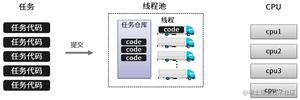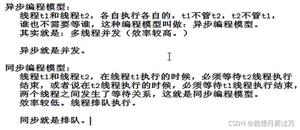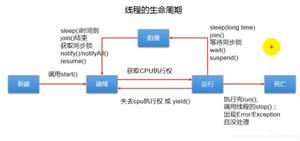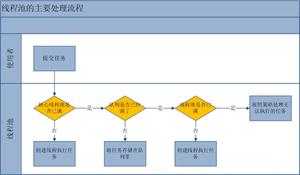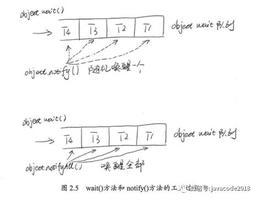java高并发之线程组详解
线程组
我们可以把线程归属到某个线程组中,线程组可以包含多个线程以及线程组,线程和线程组组成了父子关系,是个树形结构,如下图:
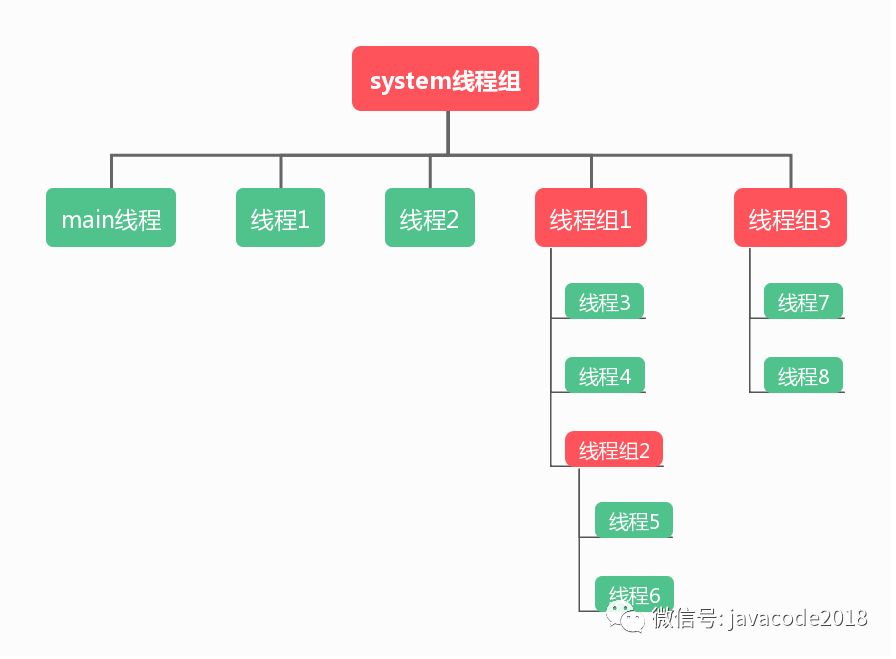
使用线程组可以方便管理线程,线程组提供了一些方法方便方便我们管理线程。
创建线程关联线程组
创建线程的时候,可以给线程指定一个线程组,代码如下:
package com.itsoku.chat02;
import java.util.concurrent.TimeUnit;
/**
* <b>description</b>:<br>
* <b>time</b>:2019/7/13 17:53 <br>
* <b>author</b>:微信公众号:路人甲Java,专注于java技术分享(带你玩转 爬虫、分布式事务、异步消息服务、任务调度、分库分表、大数据等),喜欢请关注!
*/
public class Demo1 {
public static class R1 implements Runnable {
@Override
public void run() {
System.out.println("threadName:" + Thread.currentThread().getName());
try {
TimeUnit.SECONDS.sleep(3);
} catch (InterruptedException e) {
e.printStackTrace();
}
}
}
public static void main(String[] args) throws InterruptedException {
ThreadGroup threadGroup = new ThreadGroup("thread-group-1");
Thread t1 = new Thread(threadGroup, new R1(), "t1");
Thread t2 = new Thread(threadGroup, new R1(), "t2");
t1.start();
t2.start();
TimeUnit.SECONDS.sleep(1);
System.out.println("活动线程数:" + threadGroup.activeCount());
System.out.println("活动线程组:" + threadGroup.activeGroupCount());
System.out.println("线程组名称:" + threadGroup.getName());
}
}
输出结果:
threadName:t1
threadName:t2
活动线程数:2
活动线程组:0
线程组名称:thread-group-1
activeCount()方法可以返回线程组中的所有活动线程数,包含下面的所有子孙节点的线程,由于线程组中的线程是动态变化的,这个值只能是一个估算值。
为线程组指定父线程组
创建线程组的时候,可以给其指定一个父线程组,也可以不指定,如果不指定父线程组,则父线程组为当前线程的线程组,java api有2个常用的构造方法用来创建线程组:
public ThreadGroup(String name)
public ThreadGroup(ThreadGroup parent, String name)
第一个构造方法未指定父线程组,看一下内部的实现:
public ThreadGroup(String name) {
this(Thread.currentThread().getThreadGroup(), name);
}
系统自动获取当前线程的线程组作为默认父线程组。
上一段示例代码:
package com.itsoku.chat02;
import java.util.concurrent.TimeUnit;
/**
* <b>description</b>:<br>
* <b>time</b>:2019/7/13 17:53 <br>
* <b>author</b>:微信公众号:路人甲Java,专注于java技术分享(带你玩转 爬虫、分布式事务、异步消息服务、任务调度、分库分表、大数据等),喜欢请关注!
*/
public class Demo2 {
public static class R1 implements Runnable {
@Override
public void run() {
Thread thread = Thread.currentThread();
System.out.println("所属线程组:" + thread.getThreadGroup().getName() + ",线程名称:" + thread.getName());
try {
TimeUnit.SECONDS.sleep(3);
} catch (InterruptedException e) {
e.printStackTrace();
}
}
}
public static void main(String[] args) throws InterruptedException {
ThreadGroup threadGroup1 = new ThreadGroup("thread-group-1");
Thread t1 = new Thread(threadGroup1, new R1(), "t1");
Thread t2 = new Thread(threadGroup1, new R1(), "t2");
t1.start();
t2.start();
TimeUnit.SECONDS.sleep(1);
System.out.println("threadGroup1活动线程数:" + threadGroup1.activeCount());
System.out.println("threadGroup1活动线程组:" + threadGroup1.activeGroupCount());
System.out.println("threadGroup1线程组名称:" + threadGroup1.getName());
System.out.println("threadGroup1父线程组名称:" + threadGroup1.getParent().getName());
System.out.println("----------------------");
ThreadGroup threadGroup2 = new ThreadGroup(threadGroup1, "thread-group-2");
Thread t3 = new Thread(threadGroup2, new R1(), "t3");
Thread t4 = new Thread(threadGroup2, new R1(), "t4");
t3.start();
t4.start();
TimeUnit.SECONDS.sleep(1);
System.out.println("threadGroup2活动线程数:" + threadGroup2.activeCount());
System.out.println("threadGroup2活动线程组:" + threadGroup2.activeGroupCount());
System.out.println("threadGroup2线程组名称:" + threadGroup2.getName());
System.out.println("threadGroup2父线程组名称:" + threadGroup2.getParent().getName());
System.out.println("----------------------");
System.out.println("threadGroup1活动线程数:" + threadGroup1.activeCount());
System.out.println("threadGroup1活动线程组:" + threadGroup1.activeGroupCount());
System.out.println("----------------------");
threadGroup1.list();
}
}
输出结果:
所属线程组:thread-group-1,线程名称:t1
所属线程组:thread-group-1,线程名称:t2
threadGroup1活动线程数:2
threadGroup1活动线程组:0
threadGroup1线程组名称:thread-group-1
threadGroup1父线程组名称:main
----------------------
所属线程组:thread-group-2,线程名称:t4
所属线程组:thread-group-2,线程名称:t3
threadGroup2活动线程数:2
threadGroup2活动线程组:0
threadGroup2线程组名称:thread-group-2
threadGroup2父线程组名称:thread-group-1
----------------------
threadGroup1活动线程数:4
threadGroup1活动线程组:1
----------------------
java.lang.ThreadGroup[name=thread-group-1,maxpri=10]
Thread[t1,5,thread-group-1]
Thread[t2,5,thread-group-1]
java.lang.ThreadGroup[name=thread-group-2,maxpri=10]
Thread[t3,5,thread-group-2]
Thread[t4,5,thread-group-2]
代码解释:
1.threadGroup1未指定父线程组,系统获取了主线程的线程组作为threadGroup1的父线程组,输出结果中是:main
2.threadGroup1为threadGroup2的父线程组
3.threadGroup1活动线程数为4,包含了threadGroup1线程组中的t1、t2,以及子线程组threadGroup2中的t3、t4
4.线程组的list()方法,将线程组中的所有子孙节点信息输出到控制台,用于调试使用
根线程组
获取根线程组
package com.itsoku.chat02;
/**
* <b>description</b>:<br>
* <b>time</b>:2019/7/13 17:53 <br>
* <b>author</b>:微信公众号:路人甲Java,专注于java技术分享(带你玩转 爬虫、分布式事务、异步消息服务、任务调度、分库分表、大数据等),喜欢请关注!
*/
public class Demo3 {
public static void main(String[] args) {
System.out.println(Thread.currentThread());
System.out.println(Thread.currentThread().getThreadGroup());
System.out.println(Thread.currentThread().getThreadGroup().getParent());
System.out.println(Thread.currentThread().getThreadGroup().getParent().getParent());
}
}
运行上面代码,输出:
Thread[main,5,main]
java.lang.ThreadGroup[name=main,maxpri=10]
java.lang.ThreadGroup[name=system,maxpri=10]
null
从上面代码可以看出:
1.主线程的线程组为main
2.根线程组为system
看一下ThreadGroup的源码:
private ThreadGroup() { // called from C code
this.name = "system";
this.maxPriority = Thread.MAX_PRIORITY;
this.parent = null;
}
发现ThreadGroup默认构造方法是private的,是由c调用的,创建的正是system线程组。
批量停止线程
调用线程组interrupt(),会将线程组树下的所有子孙线程中断标志置为true,可以用来批量中断线程。
示例代码:
package com.itsoku.chat02;
import java.util.concurrent.TimeUnit;
/**
* <b>description</b>:<br>
* <b>time</b>:2019/7/13 17:53 <br>
* <b>author</b>:微信公众号:路人甲Java,专注于java技术分享(带你玩转 爬虫、分布式事务、异步消息服务、任务调度、分库分表、大数据等),喜欢请关注!
*/
public class Demo4 {
public static class R1 implements Runnable {
@Override
public void run() {
Thread thread = Thread.currentThread();
System.out.println("所属线程组:" + thread.getThreadGroup().getName() + ",线程名称:" + thread.getName());
while (!thread.isInterrupted()) {
;
}
System.out.println("线程:" + thread.getName() + "停止了!");
}
}
public static void main(String[] args) throws InterruptedException {
ThreadGroup threadGroup1 = new ThreadGroup("thread-group-1");
Thread t1 = new Thread(threadGroup1, new R1(), "t1");
Thread t2 = new Thread(threadGroup1, new R1(), "t2");
t1.start();
t2.start();
ThreadGroup threadGroup2 = new ThreadGroup(threadGroup1, "thread-group-2");
Thread t3 = new Thread(threadGroup2, new R1(), "t3");
Thread t4 = new Thread(threadGroup2, new R1(), "t4");
t3.start();
t4.start();
TimeUnit.SECONDS.sleep(1);
System.out.println("-----------threadGroup1信息-----------");
threadGroup1.list();
System.out.println("----------------------");
System.out.println("停止线程组:" + threadGroup1.getName() + "中的所有子孙线程");
threadGroup1.interrupt();
TimeUnit.SECONDS.sleep(2);
System.out.println("----------threadGroup1停止后,输出信息------------");
threadGroup1.list();
}
}
输出:
所属线程组:thread-group-1,线程名称:t1
所属线程组:thread-group-1,线程名称:t2
所属线程组:thread-group-2,线程名称:t3
所属线程组:thread-group-2,线程名称:t4
-----------threadGroup1信息-----------
java.lang.ThreadGroup[name=thread-group-1,maxpri=10]
Thread[t1,5,thread-group-1]
Thread[t2,5,thread-group-1]
java.lang.ThreadGroup[name=thread-group-2,maxpri=10]
Thread[t3,5,thread-group-2]
Thread[t4,5,thread-group-2]
----------------------
停止线程组:thread-group-1中的所有子孙线程
线程:t4停止了!
线程:t2停止了!
线程:t1停止了!
线程:t3停止了!
----------threadGroup1停止后,输出信息------------
java.lang.ThreadGroup[name=thread-group-1,maxpri=10]
java.lang.ThreadGroup[name=thread-group-2,maxpri=10]
停止线程之后,通过list()方法可以看出输出的信息中不包含已结束的线程了。
总结
本篇文章就到这里了,希望能够给你带来帮助,也希望您能够多多关注的更多内容!
以上是 java高并发之线程组详解 的全部内容, 来源链接: utcz.com/p/250102.html


